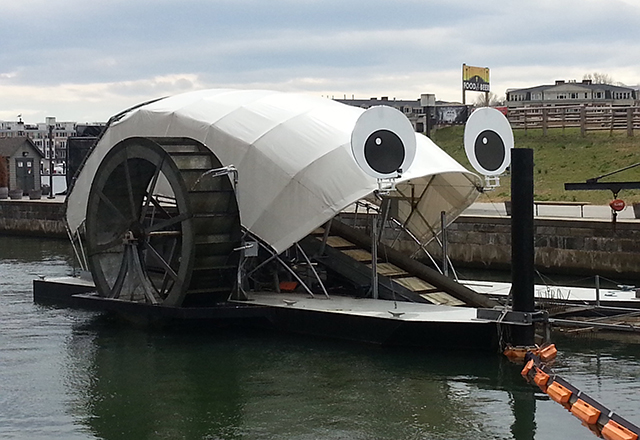As a graduate student with little money and no television, I spend much of my free time walking along the waterfront. One of my favorite stretches is the brick-paved path along Canton, which is lined with moored boats, quiet row homes and green space. A striking feature of this walk, tucked in one of the many inlets of the curving shoreline, is a white, googly-eyed carapace that tirelessly works to clear Baltimore’s waterways. Her name is Professor Trash Wheel, and she sits at the outlet of Harris Creek collecting tons of trash as it washes downstream into the harbor. Professor Trash Wheel and the rest of her family, the elder Mr. Trash Wheel and younger Captain Trash Wheel, have become a cultural and environmental phenomenon in their endeavors to guard Baltimore waters from pollution.
For years, scientists and politicians have hemmed and hawed about how to clean waterways in an eco-friendly, cost-efficient way. While talking heads were talking, local John Kellet was fixing the problem. In 2008, he debuted his original trash wheel, which was mechanistically similar to what is visible along the waterfront today: Short floating barriers span the water outlet to ensure all trash is shepherded toward the trash wheel. The trash wheel is powered by the water current and supplemented by solar panels. The wheel drives a series of rakes that pull trash from where it floats atop the water onto a conveyer belt, then into a dumpster. The dumpster barge can be swapped when the dumpster is full. After a three-year trial, the original trash wheel was removed because it could not keep up with the volume of trash entering the harbor. Fortunately, many local companies saw the value in this simple solution to a prevalent problem, so in 2014, Mr. Trash Wheel was erected at the mouth of the Jones Falls in the Inner Harbor, where he can intercept run-off litter from roughly 78 square miles of heavily developed land.
The trash wheels have made a huge environmental and social splash for two main reasons.
- They elegantly address a huge ecological problem while leaving a tiny environmental footprint. The trash wheels require no fuel for travel and, since they stay near the shore, minimal fuel to empty collected trash. The floats remain above the water and leave underwater ecosystems unscathed. In fact, the water wheels introduce new oxygen into typically oxygen-deprived environs. Perhaps most importantly, they catch the problem at the source, rather than in the sea, before the plastic has partially degraded.
- They increase visibility for water cleanup efforts. The trash wheels are near the shore and dynamic to watch, making them an eye-catching reminder of the efforts to eliminate litter. Informative signage on walkways near the trash wheels educates passers-by and raises public awareness and interest. Although waterway pollution is a disheartening topic and the solutions are typically far offshore, out of sight and mind, the trash wheels act as mascots of cleanup and spark conversation.
Baltimore is teeming with trash wheel fans. Trash birthday cakes have been gifted to Mr. Trash Wheel, and trash wheel plushies (the proceeds of which support harbor cleanup efforts) occupy stores around Baltimore. However, perhaps the biggest trash wheel fans are the owners of Peabody Heights Brewery. They have partnered with the Waterfront Partnership’s Healthy Harbor Initiative to release three beers within the last three years celebrating these Baltimore icons. The first verbosely named beer, Mr. Trash Wheel’s Lost Python Ale, was named after the python that found itself embedded in the apparatus after a 2015 storm. It debuted Earth Day 2017 and earned over $7,000 in proceeds for Healthy Harbor. The second beer, Professor Trash Wheel Blinded Me Wit Science, is a Belgian wit that was released the following Earth Day to celebrate my favorite trash wheel. Its name stacks puns upon puns and harkens to the 1982 song by Thomas Dolby, who is himself a Baltimore resident and professor at the Peabody Institute at Johns Hopkins. And in honor of Mr. Trash Wheel’s fifth birthday, Peabody Heights Brewery released a gose named Solar Power Sour this past May. Baltimore appreciates clean water and good beer, and the trash wheels have managed to bridge this gap.
Mr. Trash Wheel alone has collected over a million pounds of trash since 2014, and his success has sparked global efforts to expand the trash wheel family beyond the bounds of Baltimore to places such as Honolulu, Milwaukee, Denver and as far as Lombok, Indonesia, Panama City and Rio de Janeiro. Although I’m excited about the prospects of even more trash wheels around Baltimore and abroad, the Professor will remain my favorite as the be-lashed worker indefatigably keeping my waterfront walks clean.
References
Related content
- Water Conservation, Research and Life in Cape Town, South Africa
- Hopkins Outreach at the B’More Healthy Expo
Want to read more from the Johns Hopkins School of Medicine? Subscribe to the Biomedical Odyssey blog and receive new posts directly in your inbox.
"Mr Trash Wheel Baltimore Inner Harbor"by A.Currell is licensed under CC BY-NC 2.0
